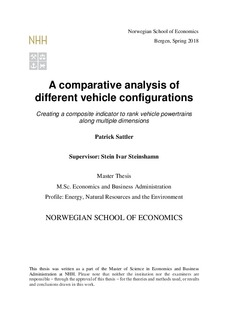A comparative analysis of different vehicle configurations : creating a composite indicator to rank vehicle powertrains along multiple dimensions
Master thesis
Permanent lenke
http://hdl.handle.net/11250/2559895Utgivelsesdato
2018Metadata
Vis full innførselSamlinger
- Master Thesis [4372]
Sammendrag
A comparative assessment of internal combustion engine vehicles (ICEVs), battery electric
vehicles (BEVs), full hybrid electric vehicles (HEVs), plug-in hybrid electric vehicles
(PHEVs) and fuel cell electric vehicles (FCVs) is conducted. For each powertrain a reference
vehicle is identified in the compact car segment. Five dimensions are selected in order to better
understand advantages and disadvantages of the single powertrains, namely: CO2 emissions,
NOx emissions, price of vehicle, driving range and noise pollution. A composite indicator
including all dimensions simultaneously is created and different weights are assigned to either
focus on environmental aspects of the vehicle or dimensions affecting the consumer’s choice
of purchasing. The results show that in regards to the reference vehicle BEVs and FCVs are
the more environmentally-benign options with respect to their emissions in vehicle operation.
HEVs on the other hand have the best composite indicator leading the dimensions noise and
price reflecting affordability. The life-cycle analysis and well-to-wheel approach are not
considered in the assessment.
